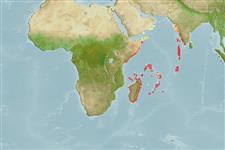Actinopterygii (peixes com raios nas barbatanas) >
Clupeiformes (Herrings) >
Clupeidae (Herrings, shads, sardines, menhadens) > Dorosomatinae
Etymology: Sardinella: Latin and Greek, sarda = sardine; name related to the island of Sardinia; diminutive (Ref. 45335).
Ambiente / Clima / Intervalo
Ecologia
; marinhas; intervalo de profundidade 0 - 50 m (Ref. 188). Tropical, preferred ?; 20°N - 27°S, 41°E - 83°E (Ref. 188)
Western Indian Ocean: western coasts of southern India, from Bombay south to Sri Lanka; also to Madagascar and Mauritius. Northwest Pacific: Taiwan (Ref. 12711), Hong Kong (Ref. 31075) and Viet Nam (Ref. 9706).
Tamanho / Peso / Idade
Maturity: Lm ? range ? - ? cm
Max length : 12.0 cm SL macho/indeterminado; (Ref. 188); common length : 10.0 cm SL macho/indeterminado; (Ref. 188)
Espinhos dorsais (total): 0; Raios dorsais moles (total): 13-21; Espinhos anais 0; Raios anais moles: 12 - 23. Total number of scutes 31 or 32. Lower gill rakers 88 to 126 (in fishes 9.5 to 11 cm standard length, strongly increasing with size of fish). Vertical striae on scales not meeting at center. The only other species of Sardinella with such a high gill raker count (more than 87) is S. fijiense (black caudal tips, western Pacific).
Forms schools in coastal waters.
Life cycle and mating behavior
Maturidade | Reprodução | Desova | Ovos | Fecundidade | Larvas
Whitehead, P.J.P., 1985. FAO Species Catalogue. Vol. 7. Clupeoid fishes of the world (suborder Clupeioidei). An annotated and illustrated catalogue of the herrings, sardines, pilchards, sprats, shads, anchovies and wolf-herrings. FAO Fish. Synop. 125(7/1):1-303. Rome: FAO. (Ref. 188)
Categoria na Lista Vermelha da IUCN (Ref. 115185)
CITES (Ref. 94142)
Not Evaluated
Ameaça para o homem
Harmless
Utilização humana
Pescarias: pouco comercial
Mais informação
Nomes comunsSinónimosMetabolismoPredadoresEcotoxicologiaReproduçãoMaturidadeDesovaFecundidadeOvosDesenvolvimento dos ovos
ReferênciasAquaculturaPerfil para aquaculturaEstirpesGenéticaFrequência dos alelosHereditariedadeDoençasProcessamentoMass conversion
ColaboradoresFotografiasStamps, CoinsSonsCiguateraVelocidadeTipo de nataçãoÁrea branquialOutras referênciasCérebrosVisão
Ferramentas
Relatórios especiais
Descarregue XML
Fontes da internet
Estimates of some properties based on models
Phylogenetic diversity index (Ref.
82805): PD
50 = 0.5000 [Uniqueness, from 0.5 = low to 2.0 = high].
Nível Trófico (Ref.
69278): 2.9 ±0.3 se; Based on size and trophs of closest relatives
Resiliência (Ref.
69278): Médio, tempo mínimo de duplicação da população 1,4 - 4,4 anos (Preliminary K or Fecundity.).
Vulnerabilidade (Ref.
59153): Low to moderate vulnerability (30 of 100) .
